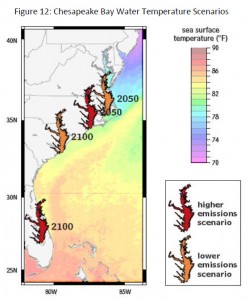Today COG is releasing our climate change adaptation report for the Region. Spurred by a technical assistance grant from EPA in 2010 COG began meeting with member jurisdictions to discuss adaptation planning strategies. The report serves to not only identify the direct effects of climate change but also to advance a dialogue for local resiliency plans in the region.
The next decades will bring the effects of climate change –rising sea levels warmer climates more extreme weather – to the globe the nation and our region. The Chesapeake Bay Area is virtually certain to experience higher sea levels which will impact water levels in the tidal portions of the Potomac and Anacostia rivers. The region will very likely see higher temperatures and precipitation concentrated in heavier events.
Changes in Water Systems Precipitation
Though sea levels are rising around the world the Mid Atlantic and Chesapeake Bay Region also experience local land subsidence. The report estimates that sea levels have risen a foot in the Chesapeake Bay and will continue to rise another 1-3 feet by the year 2100. Recently reaffirmed by the Maryland Climate Change Commission this rise in Chesapeake water levels requires planning for additional impacts on coastal areas including the communities along the tidal Potomac and Anacostia rivers.

Extreme precipitation events will increase causing flooding and damaged property. In the US flood-prone lands will increase by 40 to 45-percent over the next 90 years and as development in the DC region grows preparation will be required in low lying areas. Flooding due to megastorms combined with wind and precipitation damage costs the region millions of dollars annually and is increasingly punctuated by “billion dollar events” like 2003’s Hurricane Isabel and last year’s Hurricane Sandy. This does not account for the dozens of lives lost in these events.
The report finds that as temperatures risethe Chesapeake will effectively travel south in terms of temperature change. If greenhouse gases are not substantially reduced by 2050 the summer water temperature of America’s largest estuary could mirror today’s North Carolina Sound; by 2100 the temperature may mirror the Central Coast of Florida. Rising temperatures and increased CO2 will decrease dissolved oxygen levels and acidification of the water threatening oyster beds and aquatic vegetation. This has major implications for water quality throughout the region.
Preparing the Region
COG worked with a broad coalition of local stakeholders to develop the information summarized in this report and engage member communities with preparedness awareness. COG is working with various agencies in the region grappling with climate changes such as NASA. “COG [began] working with us and others in preparation for events to explore the DC area’s climate risks to define practical adaptations and to explore how many organizations can work together to adapt” notes Kim Toufectis a Master Planer at NASA. “What began in New York we look forward to sharing with our hometown” continued Toufectis highlighting the importance of applying best practices in climate adaptability.

Other federal agencies like the National Capital Planning Commission and the General Services Administration were able to benefit from COG’s efforts. Robin Snyder GSA Greening Officer for the National Capital highlighted “the report provides specific information tailored to our region on what to expect from climate change and how to improve the resiliency of our facilities and operations” and cited the report as “critically important in educating our workforce and planning our adaptation efforts.” NCPC which is working to address climate risks in the monumental core of Washington DC with others who are actively engaged in planning land use water and transportation in the Capital has found “COG’s work in convening forums and developing this regional climate adaptation report … extremely useful” according to Julia Koster NCPC’s Director of Public Engagement.
COG has worked extensively to address the root causes of global warming establishing greenhouse gas (GHG) reduction goals and a Climate and Energy Action Plan to mitigate emissions. This new report has found citing regional climate experts that local impacts will be substantial. Reducing global emissions is the crucial factor in reducing risks of climate change in the long term. The report says there is virtual certainty that climate change will continue to impact our infrastructure safety and health for decades reducing the severity of those changes through adaptation and emissions reductions measures is critical for our region.
This report outlines clear steps for how to adapt to the effects of climate change. We identify key areas for preparedness including hardening our transportation water and energy infrastructure smart development with more resilient land use practices and the continued engagement of the climate science community. COG will continue to engage local partners to plan for the future and work to reduce in carbon emissions in the region.